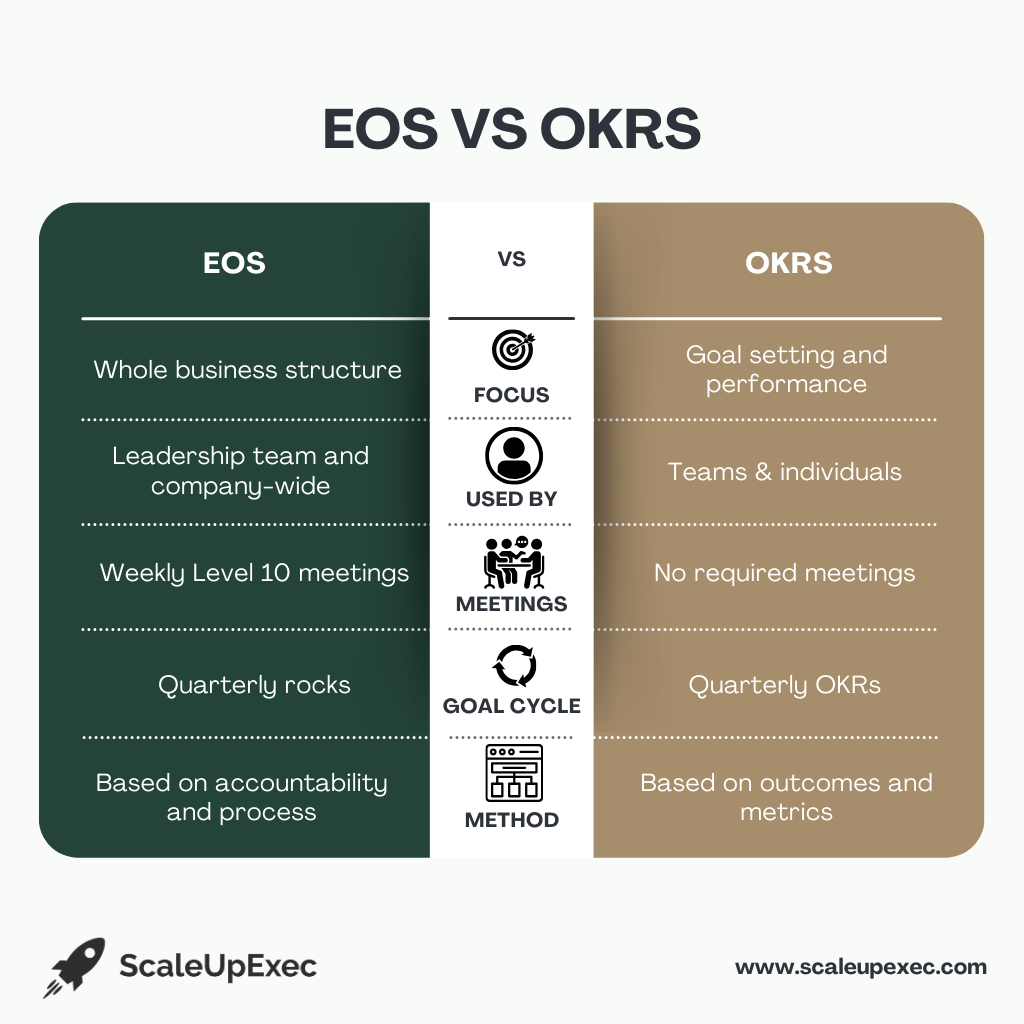EOS and OKRs are two popular systems used by growing businesses to stay focused and organized. They help teams set goals, measure progress, and improve communication. But while they may seem similar, they serve different purposes and follow different methods.
EOS stands for the Entrepreneurial Operating System. It’s a full framework designed to help leadership teams manage all parts of the business, including people, meetings, data, and processes. EOS helps companies create structure and run more smoothly.
OKRs stands for Objectives and Key Results. This system is focused only on goal setting. It helps teams and individuals stay aligned by setting clear objectives and measuring success with key results. OKRs are used by companies like Google to drive performance and focus.
How EOS Works in a Business
EOS is a complete operating system. It covers six key areas of business: Vision, People, Data, Issues, Process, and Traction. The goal is to build a strong foundation so that everyone knows what they’re doing and why it matters.
Companies that use EOS follow a weekly rhythm. They hold Level 10 Meetings, solve problems using the IDS (Identify, Discuss, Solve) method, and set 90-day priorities called Rocks. This structure keeps the business aligned and moving forward.
For companies that don’t have full-time leadership in place, outsourced COO services for growth can help implement EOS properly and keep the system running strong.
How OKRs Work in a Business

OKRs are focused on setting and tracking goals. Each objective answers the question, “What do we want to achieve?” Key results answer, “How will we measure success?” This system is often used quarterly and applies to both teams and individuals.
OKRs are more flexible than EOS. They don’t require a full meeting structure or company-wide framework. They can be used alongside other systems, including EOS, to give added focus on performance.
Many tech companies use OKRs to stay aligned across fast-moving teams. They are ideal for businesses that already have strong operations in place but want a clearer way to measure growth and progress.
EOS vs. OKRs: Key Differences
While both systems help drive results, they are different in how they are used:

EOS is more structured and works well for companies needing full alignment. OKRs are more lightweight and work best when strong systems are already in place.
For businesses in early growth stages, startup scaling with fractional COO support can help decide which system or combination will work best.
Can You Use EOS and OKRs Together?
Yes, many companies use both systems together. EOS provides the structure for running the business, while OKRs provide the focus for specific goals. For example, EOS Rocks can align with OKRs to ensure both strategic direction and measurable progress.
However, it’s important to avoid confusion. Mixing too many systems without a clear process can lead to miscommunication. That’s why some companies bring in operations support to help guide the process.
If you’re wondering, do I need a fractional COO 7 signs it’s time, one sign is struggling to keep systems consistent across teams. A fractional COO can step in and bring clarity to how EOS and OKRs should work together.
Which Is Better for Your Business?
It depends on what your business needs most right now.
If your team lacks structure, has messy meetings, or struggles to solve problems, EOS can bring order and alignment. It works best when leadership is ready to commit to a proven framework.
If your company already runs smoothly but needs better goal tracking and individual accountability, OKRs might be a better fit. They are easier to roll out but require a disciplined team to be effective.
Some companies also find success using OKRs as a smaller step before moving to a full EOS system.
When to Bring in Help

Choosing the right system and using it well takes experience. Many companies don’t have the time or leadership resources to manage this on their own. That’s where operational help makes a big difference.
For early-stage startups, fractional COO before Series A can make sure systems are in place before things scale too fast. These leaders bring experience in both EOS and OKRs, helping the business choose, implement, and manage the right tools for growth.
They also help make sure the system doesn’t fall apart under pressure. Having a steady hand guiding your team through structure, planning, and accountability is key to making either system work.
Final Thoughts
EOS and OKRs both help businesses grow, but in different ways. EOS is a complete operating system for managing your company. OKRs are a goal-setting method that helps drive performance and alignment.
Some companies choose one. Others use both. The right choice depends on your business stage, leadership strength, and current systems. If your team struggles with alignment, planning, or execution, it may be time to get extra help.
Whether you’re building out EOS, rolling out OKRs, or looking for structure to scale, support from a fractional COO can keep your business on the right path.
At ScaleUpExec, you don’t just get help with EOS or OKRs; you gain access to seasoned COOs who have scaled companies from startup to exit. We bring enterprise-level talent to SMBs at less than half the cost of a full-time hire, ensuring your systems deliver real, measurable results. Contact us today
to see how we can help.







